Estimated reading time: 18 minutes
Humankind has been using animals for various reasons for as long as history has been recorded. Dogs are often touted as “man’s best friend” and with good reason; they have been protecting us and our livelihoods without asking anything in return.
In a post-collapse scenario, dogs will play a vital role in security. This is because protecting yourself will be a major concern since law enforcement and other agencies won’t be able to protect your community. Having a guard dog is not only good for safeguarding you and your family but also plays the role of companion.
How do you know what breed of dog to get, though? With countless breeds, both pure-bred and mixed, you’ll notice that some dogs may not fit the role of security guard for you. This article will show you the best dog breeds you can find for protection in a post-collapse society.
Want to save this article for later? Click Here to Pin It On Pinterest!
Characteristics of an Effective Guard Dog
Guard dogs are meant to alert you to any perceived intruders without attacking them unless you command them. A good breed should display a sense of fearlessness which can be achieved through appearance and size.
However, that doesn’t mean you should go after the largest and most ferocious animal you can find. Several factors need to be considered before making your choice that go beyond just intimidation and the ability to bark loudly.
Keep in mind that the general rules of owning a dog will still be very much in play, even post-collapse. Dogs need affection, shelter, food, exercise, and deep companionship for them to build up the loyal foundation needed for effective protection.
Responsiveness to Training
Training your dog to protect your family needs to be started at a young age. Simply picking up an adult dog and expecting it to know what to do will end up negatively affecting both you and the animal.
Adult dogs have behavior mechanisms and other tendencies that need to be overwritten and an established personality can make that difficult. If you’ve heard the saying, “You can’t teach an old dog new tricks” then you can see how it applies to this situation.
Younger dogs may have more energy, yes, but they are more apt to listen to their owners. This means they will watch your every move and more than likely stay by your side. Having a focused training regimen can help sink in the concepts you want to teach, even in a high-energy puppy.
If you try to train a breed that is known to be too domesticated then you’re going to get nowhere with your training.
Aggression Traits
If you have a puppy that can be aggressive then you might have found a strong candidate for a guard dog. If you need an animal to protect you then you would want one that is not afraid to defend itself. If a dog won’t protect itself, then it will not protect you from predators. You’ll want to stay away from breeds that show timid characteristics, as these dogs may not be up to the challenge.
On the other hand, too much aggression can put you and your family at risk. This is especially apparent if you have kids, who generally like to get up close and personal with the family pooch.
No amount of training can limit aggressive tendencies and as such, it is not uncommon to hear of well-trained dogs attacking their own families.
Luckily, there are some easy ways to determine whether the dog is too aggressive, including:
- Does the dog initiate play with other dogs?
- How alert are they to you approaching them?
- What is their attitude like towards other dogs and humans?
- How does the dog look when around others?
If there are dogs around playing and yours has its hackles up, it might be a sign that the animal could be too aggressive to train properly.
Dominance
Why are there pockets of people who strongly dislike small dogs over large dogs? Well, the consensus is that smaller dogs are loud, in your face, and always trying to start problems with others. A strong guard dog will not exhibit these high-energy traits because they are not trying to be dominant, they just are.
Look for an animal that has the confidence to walk amongst neighboring pets without having to constantly defend a territory as the others will already sense how dominant your dog is.
If other dogs give your dog the space to move without hindrance then that is a good sign. If they try to overpower and intimidate your pooch then you might need one with more dominance.
High Intelligence and Alertness
If you approach your guard dog how does it react? Will it lie down? Or will it actively approach the individual and proceed to figure out what their intentions are?
Determining how actively alert your dog is will give you an idea of how difficult it will be to train them. While at certain times the dog may be alert enough to perceive predators you’re going to want a breed that is alert all of the time. Much like a wild animal, a good guard dog will always actively be looking at its surroundings.
Since you’ll most likely be hunting for your food at some point after a societal collapse, having an intelligent dog can help you track and even catch your prey. Some breeds, such as the Nova Scotia Duck Tolling Retriever are better at hunting ducks than other breeds due to their ability to hide and run on command.
Acquired Loyalty Potential
A dog who does not truly adore you will do the minimal effort required to protect you. The dog must perceive you as not just an owner, but the part of the pack that you truly are. The amount of loyalty your dog feels towards you will be the main reason it wants to protect its home, and as a result, you.
The interesting thing about canine loyalty is that it can be taught to the dog. You need to prove to your animal that they are a family member. This sense of belonging will push them to protect themselves and their pack. The sense of possessiveness heightens their awareness and will keep them from becoming docile.
It can include demanding action from the animal and then rewarding it for its good behavior. The training should start from a young pup if you want it to be most effective.
There are some signs that you can pay attention to even before you start the entire training process. Look for key indicators of loyalty, such as:
- Does the dog come up to you for attention?
- Will the dog lick your hand or put its paw on you?
- Will the dog stand by you if you are interacting with other dogs?
Once you find a guard dog that displays loyalty, the training to develop it becomes much easier. While this does mean you should show kindness and affection, dogs have a pack mentality where they do need to be berated for not completing a task properly. When it comes to post-collapse situations, you want a dog that can perform and not one that will cower away from a challenge.
10 Breeds That Make Great Guard Dogs
Choosing the right guard dog that can function in and out of society can seem like a daunting task. There are so many varieties and mixes to choose from that it can simply become overwhelming. Here are the top dog breeds that you should be looking at as potential guard dog candidates.
1. German Shepherd
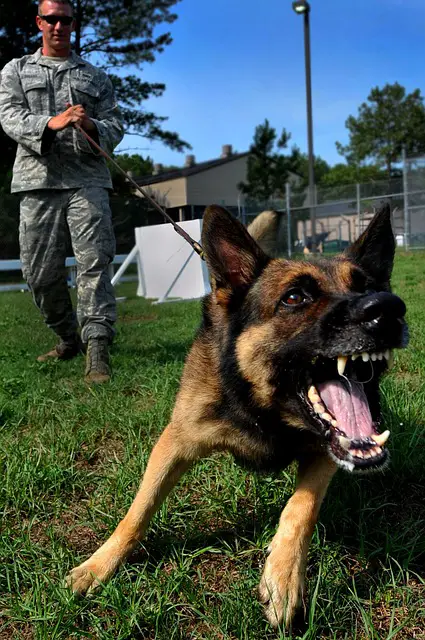
First up is one of the classic examples of incredible guard dogs that provide dominance, loyalty, and intelligence. German Shepherds are commonly associated with guard dogs as their bravery does not know any bounds. They were originally herding dogs and have an incredible sense to keep you and your family within their senses.
This breed is a quick learner which makes it easy to train. Although, sometimes they can become a little too protective and will need to be shown not to go after anyone that approaches them.
They might not be the best hunting dogs per se, but they can easily find hidden supplies, stay alert all night, and listen to their owners with no issues. German Shepherds are only loud when they need to be, making them pretty good at playing stealthy.
You can expect an average weight between 60-100 pounds and a life expectancy of up to 10 years with exceptional care providing additional years of life beyond that.
2. Bullmastiff
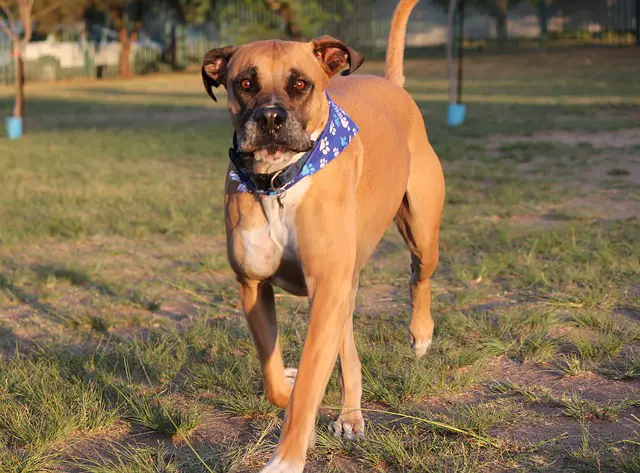
The Bullmastiff is an imposing figure with rigid muscles and keen intelligence. They were initially bred from a mix of Bulldog and Mastiff to protect the wild game from would-be poachers and required a rigid training structure to be effective. They are considered work dogs and as such, can handle long periods of being alert to predators.
They may have an intimidating presence that will deter most predators; With their family, however, they are docile and extremely affectionate. This is why building a tight bond with this breed will enhance their effectiveness at protecting you.
Having a bullmastiff will make for excellent security, but they are not good at hunting or sniffing out supplies. If you need a dog that can knock people over or block any intruders then they might be right for you.
With their huge muscle proportions, you can see them getting up to 130 pounds with a life expectancy of around 10 years.
3. Doberman Pinscher
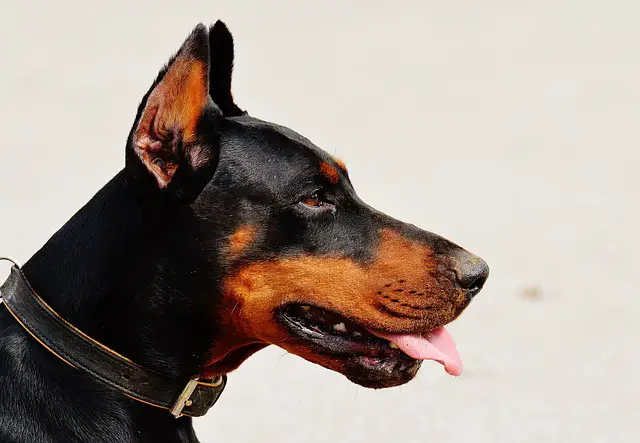
Even without a post-societal scenario, the Doberman Pinscher is a fierce animal. Not fierce in the sense that they are overly aggressive, but that they will do anything to protect their family.
They do have a bad reputation as being too aggressive which can turn some people off. However, as with all breeds, proper training can positively harness that aggression. They are incredibly affectionate with their families, often being incredibly goofy by rolling around or playing.
Their perky ears give them a keen sense of danger and you will be best to trust their instinct as they have a strong sense for bad people. Doberman Pinchers are quick to jump into action and they can apprehend intruders very quickly.
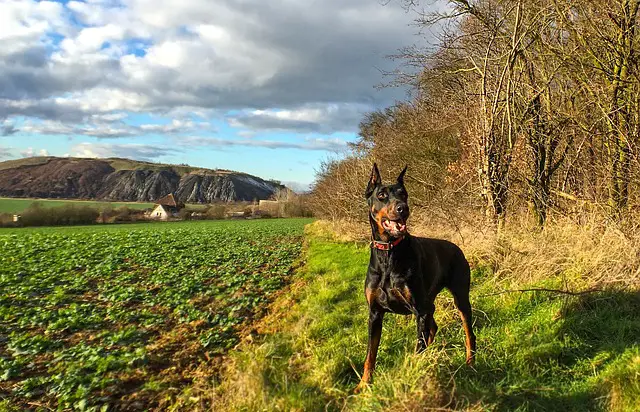
You’ll want to give them a large area to protect as their energy is nearly boundless. They require a lot of exercises to maintain their physique and alertness so ensure they have that outlet when they aren't busy protecting you.
Dobermans have a sleek coat that requires little maintenance. Expect a fairly heavy dog with a weight range between 65-100 pounds. In contrast to the other breeds mentioned thus far, they have a life expectancy between 10-12 years with a potential to go beyond with a proper diet and care.
4. Rottweilers

Another breed with a stocky build and a loud bark, the Rottweiler has been bred to be a guard dog throughout history. They have a dangerous combination of strength, instinct, and intelligence. With proper training, they can be as effective as the German Shepherd at guarding you and your family.
They are not aggressive towards those they are loyal to, often showing the same goofiness that you would find in a Doberman Pinscher. If you are looking for a playmate in the house and a security guard on the property you can’t go wrong with one of these dogs. Unfortunately, they make for better guards than hunters and you can make better use of their talents around camp.
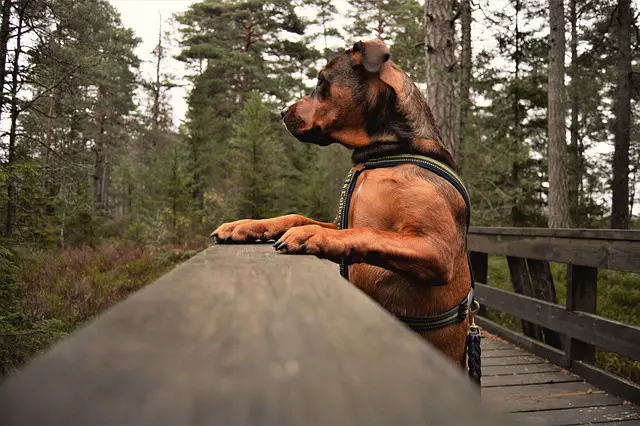
They were initially bred from Asian Mastiffs by the Romans to protect livestock from poachers and predators alike. With such a long history the Rottweiler has developed a keen instinct to protect their families. Fast forward through history and you can see them as popular police dogs and personal protectors.
The Rottweiler can live between 9 and 10 years with proper care. Expect them to beheavy feeders since they can get upwards of 135 pounds.
5. Akita

Akitas originally came from ancient Japan where they protected noble families. They are easily recognizable as being fluffy with solid bodies. An Akita may be fluffy and quiet but they are fierce in the face of an intruder.
This breed is great for keeping quiet as they do not bark much and dislike other barking dogs. With the family, they are goofy and very affectionate, especially towards children. This goofiness, however, requires obedience training to help control. If left unchecked, it can turn your Akita into an unnecessarily stubborn or standoffish animal.
Spending copious amounts of time training this dog is the key to a tight bond. Expect your Akita guard dog to weigh between 80-130 pounds with an average lifespan of up to 13 years of age.
6. Saarloos Wolfhound
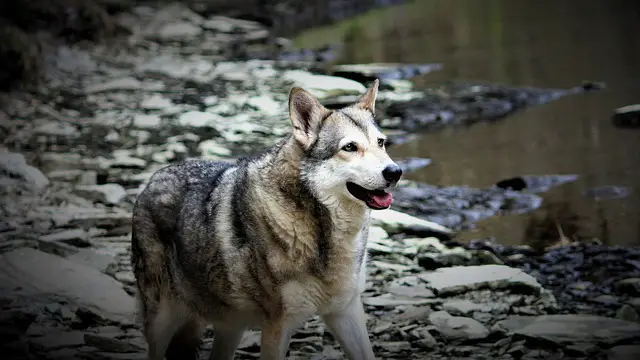
The Saarloos Wolfhound is bred from a wolf and originated in the Netherlands. Even though they come from a lupine heritage, they act more like the German Shepherd than anything, since that’s the other half of the lineage puzzle. The Saarloos Wolfhound was created as a guard dog, and with keen intelligence, they can quickly sniff out potential predators.
Interestingly, this breed is not as aggressive as their wolf heritage may suggest. They are extremely loyal to their families and will protect them with everything they have.
You will find the Saarloos Wolfhound to be extremely shy at first but with a patient owner and diligent training, you will be able to bring their confidence out to the forefront.
It is important to note that if you fail to train the animal correctly it will not feel like part of the pack and may start to act out on its own. This breed will weigh between 66-90 pounds on average with a hearty lifespan of up to 12 years.
7. Chesapeake Bay Terrier
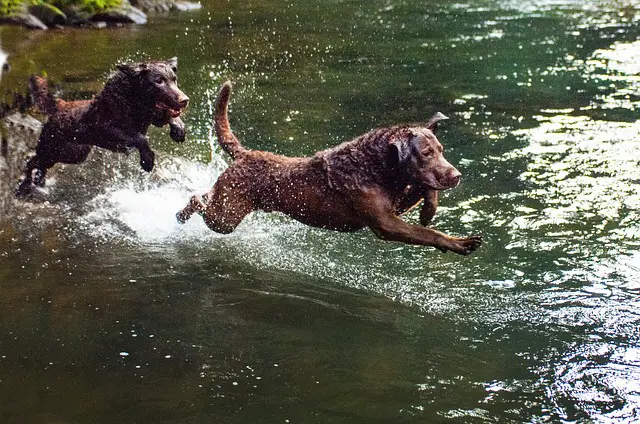
The Chesapeake Bay Terrier also called a “Chessie” is an extremely fierce and determined hunting dog. The intelligence capabilities of this breed make them able to discern predators vs. prey rather easily. Check out this breed If you are looking for a loyal protector for your family that can also act as an able gun dog for waterfowl.
Naturally stubborn, you’ll need to train them from a young age and keep them extremely active to keep this trait from surfacing. The need for activity makes them perfect if you are on the move post-collapse. Using their keen senses they can generally find things hidden in the brush

An adult Chessie will weigh between 55-80 pounds and can live up to 13 years with proper care and diet.
8. Belgian Malinois
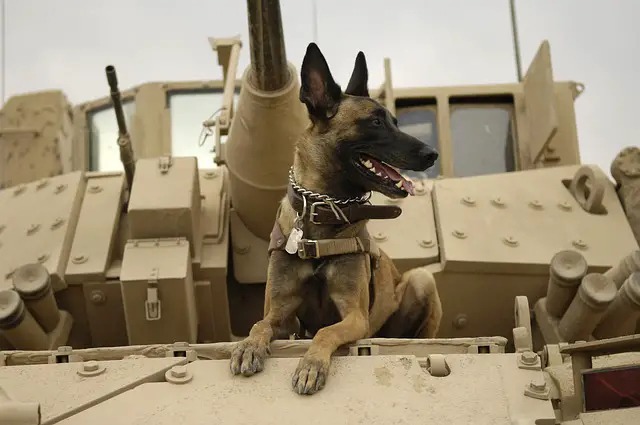
The Belgian Malinois is famous for being a police dog and is even used in the military. They can be quite similar to the German Shepherd, both in appearance and attitude.
Owning a Malinois requires a lot of training and affection since they can be quite jealous. This jealousy can turn into being territorial so committing a substantial amount of training effort is required.
A fully grown adult Malinois will weigh between 40-80 pounds with a higher life expectancy of around 16 years.
9. Komondor

The Komondor looks more like a mop than a guard dog, thanks to the natural dreadlocks this working animal has. Underneath all of that chunky fur is a large, well-muscled animal that is ready to guard your home.
They are an independent breed that would much rather guard your livestock than interact with strangers. That being said, they are fiercely protective of their families.
Since the Komondor has an independent temperament you’ll want to spend a lot of time training it. Homeowners in the suburbs consider this breed to be “too much dog” in both size and intelligence, but in a post-collapsed world, you want as many of those characteristics as possible.
The average weight of this breed is between 80-100 pounds with about 15 pounds coming directly from the matted dreads. In a good home, the Komondor can give up to 12 years of age.
10. Rhodesian Ridgeback

The Rhodesian Ridgeback was originally bred to hunt lions. This member of the hound group is highly affectionate and loyal to their families. The “ridgeback” part of their name comes from the distinct ridge of fur that grows along the top of their back. Think of it as elongated hackles that can be raised when they’re on alert.
Not a noisy animal, this breed will only bark when there is trouble afoot. Their keen senses and wiry physique make them quick to act on anything suspicious, including getting rid of unwanted guests.
The Rhodesian Ridgeback has a dominant personality that can get out of hand without proper training. They won’t necessarily be hunting any lions for you but they can make for a great warning signal and guard for your family.
The average weight of this breed is between 60-80 pounds with a lifespan between 10-12 years.
Tips On Choosing the Right Breed
Picking the right guard dog breed for your family isn’t as simple as going to a breeder and finding the right pup. Do your due diligence in researching everything you can about the breed that interests you. To help you get started, here are some handy tips you can use to ensure you are making the right choice.
Check Breed History For Physical or Mental Problems
Different breeds have issues that can affect the physical and mental performance of your guard dog. For example, some breeds have weak hips making them susceptible to mobility problems the further along in life they are.
Other breeds don’t have the intellectual capacity. This isn’t to say that they aren’t intelligent enough, just not the right type of intelligence to be an effective protector. You wouldn’t choose a hyperactive and quick-thinking Jack Russell Terrier to protect your family; instead, you would look for the more calm German Shepherd that can easily and effectively assess any situation for potential predators.
Fully Research Where You Get The Dog
Always check out the breeders for these animals. You need to ensure that they are providing strong genetics that have been properly maintained throughout the lineage.
Some breeders take shortcuts and this can lead to problems with your guard dog. You want a breeder who takes the time to improve any problems that may haunt a particular breed. This could be anything from physical ailments, temperament, and constitution of the breed.
Here are some things you want to check out if you’re going to go through a breeder for your guard dog.
- If they have puppies all of the time then that is a red flag. Most reputable breeders will keep a list of interested people in the future.
- Ensure that they are transparent with the family history. A breeder should be open to letting you meet the mother of the litter.
- A good breeder should provide multiple references from past dog adoptions.
Over and above that you want to ensure that the habitat provided by the breeder is sufficient enough to keep the animals happy. This includes a clean living area, fresh water, and good food.
Train the Dog Yourself
One of the most important things you can do for your dog is train it yourself. Sending your pup off to training school is still a good option; just make sure that you are the one implementing the curriculum.
This helps develop the loyalty and bond between you and your guard dog. Some people want to simply drop the dog off at the school and have someone do the hard work for them. Not only will this diminish the connection between you it will also create an environment where your commands become foreign to the dog.
Final Thoughts
Choosing the right guard dog is about choosing a breed that fits your requirements for activity level, alertness, and intelligence. You want a dog that will be kind to your family but suspicious of strangers. Pick a breed that is intimidating, either through their bark or physique to deter any would-be predators from breaking your perimeter.
Like this post? Don't Forget to Pin It On Pinterest!









